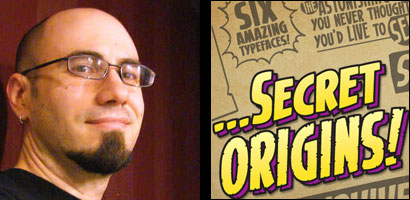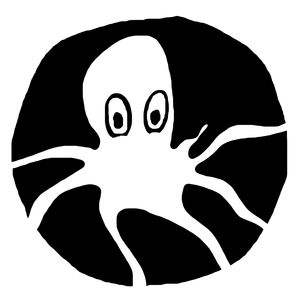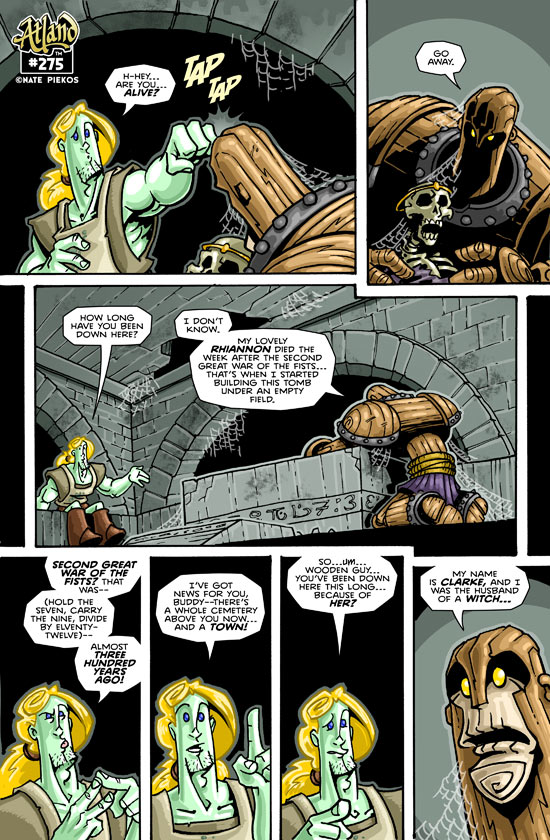
Nate Piekos and one of his many, many hand-designed typefaces.
Nate Piekos (pronounced ‘PEE-kos’) is the man behind Blambot.com, a website well known in the comic book industry for fonts, lettering, and logo design.
It’s not just the comic pros at Marvel and DC that use Nate’s fonts though. Everyone from The New Yorker to Kellogg’s Cereal to MTV to Hasbro to Hallmark have used Blambot fonts. Besides lettering comic books (which is an art in itself), designing fonts, and designing logos, he also keeps up a webcomic of his own called ATLAND and has written a few articles about his craft on Blambot.
The cool thing about Blambot is for most commercial fonts Nate releases on the site, he releases a free font as well for independent comic creators. Nate was good enough to answer a few questions for us recently.
What’s your personal history with comics? Did you always want to work in the comics industry?
I can remember drawing my own comics as a little kid, laying on the carpet in front of the TV. I started collecting seriously in my teens. I thought working in comics was a pipe-dream, really. I just did it for fun — but I never stopped doing it.
I went to college for a degree in graphic design with a focus on Corporate Identity design (logos). While I was there, I studied typography as part of my coursework.
Simultaneously, I was drawing indie comics to amuse my friends and realized I needed good (preferably free) comic book fonts. So I started making my own. A buddy of mine suggested I put them online, and Blambot was born.
After college I worked a miserable graphic design job for five years, all while working on comics at night. During that time I started working with Mike Allred who got me my first gig lettering his book (X-FORCE, later, X-STATIX) for Marvel, and that got my foot in the door.
Once I started making enough money with fonts, lettering, logo design, etc., I made the jump to being self employed in the comics industry. It’s been ever-onward from there!
So, you’re constantly lettering books for the big comic companies (right now it looks like you’re working on fourteen?), you produce two new fonts every month or so, you keep up your own weekly webcomic, and on top of that you keep up a newsletter, website, and active Twitter account. Have I missed anything? How do you produce so much? What does your average day look like?
When you put it like that, it does seem like a lot.
I’m also a gym-rat. I lift and do cardio five to six days a week. I lost 75 pounds over the course of about six or seven years.
I guess my secret is I work fast, and I work efficiently. I’m a type-A personality. I never procrastinate.
I wake up around 7:30, answer e-mail and do all the clerical mumbo-jumbo that goes along with being self employed. I assess what needs to get done for the day, be it fonts, lettering, or drawing ATLAND, and I work at it until early afternoon. I take a break to hit the gym for two hours or so, come back and work until 7:30 or 8pm. Rinse and repeat, Monday through Friday.
Wow, that’s a crazy-full schedule, Nate. Did breaking up your day that way come naturally, or did it take a while to figure out a good rhythm? Is that balance between work and play (if you count working out as play) important for your creativity, or productivity?
I guess it came out of necessity. It’s a pretty fluid process — a matter of knowing how to prioritize.
The balance between work and play is very important. It keeps things fresh to have a lot of different facets to the day.
I take weekends off, too. So that helps maintain my sanity.

Blambot’s Hometown Hero typeface.
How do you keep coming up with new fonts? And how do you decide which ones to make pro, and which ones to make free (for non-profit and independent use)? And while we’re at it, how did the idea to give some of them away for free come about in the first place?
Most of the time I’ll be lettering a book and think, “Man, I could really use a font like ______!” and I’ll start working on it for next time.
It’s kind of a roll of the dice to decide which one to make a pay font and which one to make free. Intuition mostly. Sometimes I’m wrong, but most of the time I’m right.
The idea to make free ones for indie comic artists came about from my own needs when I was an indie creator. Fonts were too expensive. Why should a poor college student be forced to go without good type for their comics? I’m there to support the up-and-coming artists.
What’s cool is that now the guys who are becoming pros remember how Blambot helped them, and give me a yell to letter their books now that they’re working mainstream.
Do you ever get bored with your job and wish you were doing something else?
Are you kidding? 🙂
I’m the luckiest guy in the world. I get to work on comic books all day, I’m my own boss, and my morning commute went from driving 100 miles a day to walking down the hall! Not a day goes by when I don’t thank the universe for my good fortune. Even on days when things get stressful, I just remind myself, “My worst day now is still better than my best day working the old nine to five.”
(Although if I had to pick another career it would either be: librarian — it was my college job and I loved it — or a musician. I’ve been playing guitar since I was a teenager. )
In your opinion, what’s the best stuff out there in the world of comics right now?
My absolute favorite comic is USAGI YOJIMBO by Stan Sakai. It’s the only book that I have to read every month. Another favorite is GROO by Sergio Aragones.
Any advice for fellow comics creators?
My best advice for aspiring creators is to remember that comics is a business. It’s WORK, not just play.
If you expect to get hired into the mainstream, you have to be talented, super fast, reliable, and have the ability to hit or exceed your deadlines.
90% of the creators who ask me for a critique have talent, but can’t force themselves to get work done when they don’t “feel like it.” That won’t fly in the big leagues. You have to be able to squeeze out your best work sitting at your drawing board, on a Saturday afternoon when all your friends are out having a good time… with a head cold… on your birthday….
If you’re okay with that, the flip side is that you’ll get to work from home, work with the people who were probably your heroes growing up, and get paid to play make-believe every day.
All images courtesy of Nate Piekos.


